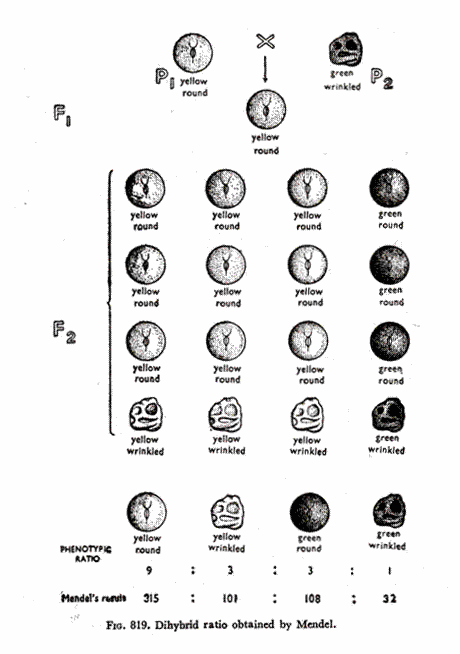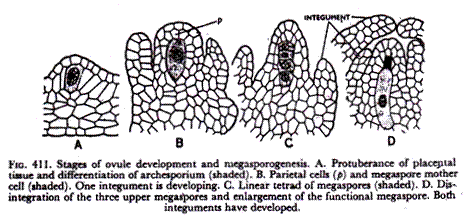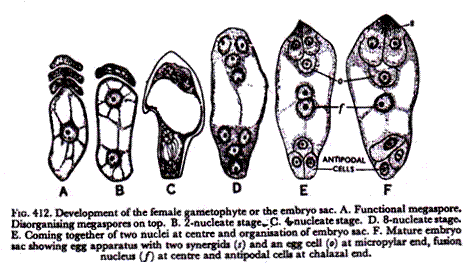ADVERTISEMENTS:
The below mentioned article highlight the two experiments of Mendel. The experiments are: (1) Segregation and Dominance: Monohybrid Experiments and (2) Independent Assortment: Dihybrid and Trihybrid Experiments.
Experiment # 1. Segregation and Dominance: Monohybrid Experiments:
After several preliminary trials, Mendel selected the edible pea (Pisum sativum) for his subject. Following his idea that the heredity of each character must be separately investigated in order to arrive at a clear and uncomplicated conclusion, he chose a number of pairs of characters and made separate crosses for each pair between varieties differing markedly in respect of the particular characters.
ADVERTISEMENTS:
As the hybrids involve single pairs of characters these are known as Monohybrid Experiments. He chose seven such character pairs, namely, (i) form of ripe seed—round or wrinkled; (ii) colour of cotyledons—yellow or green; (iii) colour of seed-coats and flowers—coloured or white; (iv) form of pod—ripe pod simply inflated or constricted between pods; (v) colour of pod—unripe pod green or yellow; (vi) position of flowers—arranged along axis or bunched at top; and (vii) length of stem (i.e., height of plant)—tall (6 to 7ft.) or dwarf (3/4to 1½ ft.). It will be found out later that Mendel was specially lucky in getting perfect dominance in all these cases and in having the seven characters located in seven different chromosomes. Otherwise, his results could not have been so clear.
The pea plants are naturally self-fertilised. Mendel first carried on his experiment separately for each pair of characters. For each pair he crossed between two suitable plants of the proper varieties and grew the hybrid seed. The hybrid plant represents the first filial generation or the F1 The F1 plant self-fertilised itself, all its seed was collected and planted to form the second filial generation or F2. Then the seed of each F2 plant was planted separately to form a number of separate F2 populations.
The result obtained by Mendel in the Tall x Dwarf cross is diagrammatically represented in Fig. 817.
ADVERTISEMENTS:
The results were exactly similar in all the seven different crosses.
Mendel found that in the case of each cross:
1. In the F1, one character of each pair disappeared. The character that showed itself in the F1 he signified as dominant while the character that did not show was termed recessive. In the list of the seven character pairs given above, the first character is dominant and the second recessive.
2. In the F2, the parental characters reappeared. Thus, the dominant F, plant segregated into the parental types. In all these cases he found that in the F2, the dominant and the recessive types occurred in the ratio 3:1.
3. In the F3, the recessive plants bred true. But, of the dominant plants only one- third bred true while the other two-thirds again segregated in the ratio 3: 1. So, the F2 ratio, instead of being stated as 3 dominants: 1 recessive, is more correctly stated as 1 true or pure breeding dominant: 2 segregating dominant: 1 true breeding recessive.
The results obtained by Mendel are shown in the table below:
A glance at the results will show that the F2 ratios obtained were not exactly 3:1 in most cases. But, when a result is dependent on chance (any plant may die accidentally) such deviations are bound to occur. It will be shown that the results obtained by Mendel are sufficiently correct to conform to the 3:1 ratio.
Mendel explained the phenomena by assuming these principles:
1. Existence of unit character. Each character is represented by a unit in the gamete. In the zygote the two units of characters or factors from the two gametes come to lie side by side but they remain independent and do not lose their individual identities.
ADVERTISEMENTS:
2. Occurrence of characters in pairs and Dominance of characters. There are pairs of all types of characters, e.g., tallness and dwarfness for height, round and wrinkled for seed, etc. In a hybrid zygote one such unit comes from each parent and the two units lie together. When both the character units are present, only one of them shows itself and is called dominant while the other lies latent and is called recessive. Such pairs of characters are called allelomorphs or alleles.
3. Eventual segregation of units contributed by respective parents. The hybrid plants will again form gametes of two types and these gametes will pair to form zygotes of the next generation. The zygotes will be different as gametes may associate in different ways. So, the F2 plants will be of parental as well as of hybrid types.
This breaking down of the hybrid type into parental and hybrid types are called segregation which is sometimes called the First Law of Mendel. Mendel declared “it is now clear that the hybrids (F1) form seeds having one or other of the two differentiating characters and of these one half develop again the hybrid form, while the other half yields plants which remain constant and receive the dominant or the recessive characters (respectively) in equal numbers.”
ADVERTISEMENTS:
Segregation can be explained easily if we consider the association of the gametes. A gamete can contain only one unit character of each allelomorphic pair. Thus, if T and d represent the unit characters for tallness and dwarfness respectively, there can be male gametes (formed out of pollens) and female gametes (eggs) of either T or d types. Thus, when the first cross is made, one of the parents gives rise to only T gametes (within pollens) and the other to only d gametes (eggs). The F1 zygote is Td.
This Td plant now gives rise to two types of pollens resulting in two types of gametes T and d in approximately equal numbers. The same parent will also give rise to equal numbers of T and d eggs. These two types of gametes are now capable of fertilising one another freely. The above facts are diagrammatically represented in Fig. 818.
The diagram explains that the F2 segregation ratio is
1 TT: 2 Td: 1 dd
ADVERTISEMENTS:
or, 1 true breeding tall : 2 segregaing tall : 1 true breeding dwarf.
The TT plants, when self-fertilised, can form only T gametes—so they will be true breeding tails. Similarly dd plants will be true breeding dwarfs. But, the Td plants will again give rise to T and d male and female gametes so that the descendants of these plants will again segregate. Hence, the Td plants are segregating tails.
We find that among the tall F2 plants there are two types, TT and Td. These are constitutionally different as their future segregation shows but, outwardly, their appearances are the same—i.e., tall. When a group of organisms are similar in appearance but not necessarily similar in their genetic constitution, they are said to form a phenotype.
ADVERTISEMENTS:
On the other hand, organisms of the same genetic constitution form a genotype. Thus, the F1 segregation shows two phenotypes—tall and dwarf, but three genotypes—TT, Td and dd.
The zygote formed by the union of two gametes always contains two factors of an allelomorphic pair. If the two factors are the same, e.g., TT or dd, then the zygote is called a homozygote and the plant from it is homozygous. On the other hand, if the two factors are different, e.g., Td, then it is a heterozygote and the plant from it is called heterozygous. Homozygous plants are always true breeding while heterozygous ones always segregate.
In order to find out the segregation ratio, the gametes and the zygotes have been represented in the diagram in the form of a checker-board or chess-board. This method of finding out the segregation ratio is known as the Checker-board or Chess-board Method.
Experiment # 2. Independent Assortment: Dihybrid & Trihybrid Experiments:
After considering the character pairs singly, Mendel now began his experiments with two pairs of characters simultaneously and thus obtained the Dihybrid Ratio. Here again Mendel had another bit of luck in experiencing no linkage.
For a dihybrid experiment, Mendel crossed a variety having yellow cotyledons and round seeds with one having green cotyledons and wrinkled seeds. The result obtained is shown in Fig. 819.
The F2 ratio can be explained in the same way as was done in the case of the mono- hybrid ratio. Let Y represent yellow cotyledon, g green cotyledon, R round seed and w wrinkled seed. Thus, a gamete will contain either Y or g and, at the same time either R or w. The eventual segregation is explained by Fig. 820. The checker-board shows that only four phenotypes in the ratio 9 Y-R-: 3 Y-ww: 3 ggR: 1 ggww are possible because Y is dominant over g and R over w. The actual ratio obtained by Mendel is very close to its expected ratios.
ADVERTISEMENTS:
It should also be noted that the four phenotypes are composed of the following genotypes:
The ggww phenotype is a genotype by itself.
Next, Mendel worked with three pairs of characters and thus obtained a Trihybrid Ratio. He considered the same Yg and Rw alleles along with the characters coloured or white seed-coat. Putting C and c for coloured and white seed-coat respectively, his results may be shown as in Fig. 821.
The F2 segregation can be easily explained as has been done in the cases of mono- hybrid and dihybrid ratios. Naturally, the checker-board will be a little more complicated, there being 8 possible types of gametes so that the checker-board will have 8X8 = 64 squares.
Form the dihybrid and trihybrid ratios obtained, Mendel concluded his principle of independent assortment of characters which is sometimes known as Mendel’s Second Law. This states that the different factors or allelomorphic pairs in the gametes and zygotes assort themselves and segregate independently of one another.
Mendel stated the off-springs of the hybrids in which several essentially different characters are combined exhibit the terms of a series of combinations, in which the developmental series for each pair of differentiating characters are united. It is demonstrated at the same time that the relation of each pair of different characters in hybrid union is independent of the other differences in the two original parental stocks.
Polyhybrid:
If the principle of independent assortment of factors is followed, it will be found that it is possible to calculate the segregation ratio when more than three pairs of factors are considered together. Naturally, such calculation will be much more complicated. There will be a greater number of phenotypes showing a gradation almost as in fluctuating variations and a still greater number of genotypes.
The great variation of segregates will naturally cause any experimentation very difficult. Such a ratio is known as Polyhybrid Ratio and the hybrid, which is heterozygous for a large number of characters is called a Polyhybrid. Although Mendel did not work directly on this, a number of such experiments have been performed since the rediscovery of Mendel’s paper. Polyhybrid ratios are of importance in explaining the inheritance of multi-factorial quantitative characters discussed later.







